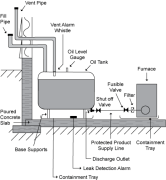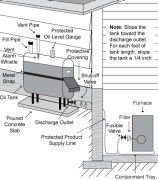Long New Brunswick winters make cold weather heating a certainty. For many, oil is the principle source of heat. If you are an oil tank owner, you should know that undertaking preventative measures with regard to your home heating tank are recommended to help safeguard your family, your home, and your environment.
As an oil tank owner, it is your responsibility to protect your property by having your tank correctly installed and looked after. Maintenance of a home oil tank is long-term, beginning at the time of purchase and ending when it is properly disposed.
Take the time to learn about oil tank upkeep. Become aware of signs that may indicate a problem. Doing so can give your family peace-of-mind and may save you money by avoiding costly spill clean-up procedures. Read on for helpful oil tank information.
Oil Tank Maintenance and Spill Prevention
Purchasing an Oil Tank
- Contact a licensed installer to purchase the oil tank.
- Request the purchase of a new tank - never used.
- Confirm that there is a label on the tank noting the date it was built and that it is approved by the Underwriters Laboratory of Canada (CAN/ULC - S602).
- Verify that the tank is made of 12 gauge steel. Corrosion resistant coating is also recommended. For outdoor installations, select a double wall tank with an inside plastic liner or a double wall fiberglass tank to avoid corrosion.
- Add spill proofing measures by purchasing a containment tray and a level alarm system, or by selecting a double wall tank.
- Research warranty options on oil tanks, and contact an insurance provider concerning coverage.
Oil Tank Installation
- Hire a licensed oil tank installer.
- Identify a clean space for the tank, accessible from all sides for inspection.
- Install the tank on a poured concrete slab. This provides a solid, non-flammable base.
- Slope the tank toward the discharge outlet to allow water in the tank to automatically exit (see notes on diagram).
- Ensure that vent and fill pipes, as well as supply lines are made of metal. Existing copper supply lines should never be reused.
- Do not allow used oil to be transferred from an old tank into a new tank. This can cause contamination by introducing water, sludge and bacteria, thereby accelerating internal corrosion of the new tank.
- Consider securing an outdoor tank with a rubber backed, metal strap around the mid-point. Attach the strapping to solid structures on either side of the tank, e.g., wall studs.
- Place a containment tray, or spill catcher, under an indoor tank as a protective measure. A leak detection alarm is also a good investment.
- Dispose of old tank contents at approved tank decommissioning sites. Call your nearest regional office of the Department of Environment for locations.
Outdoor Oil Tank Considerations
If outside tank installation cannot be avoided, have a licensed installer locate the tank on the north or north west side of the house to reduce condensation due to weather exposure. Use a double wall tank with an inside plastic liner or a double wall fiberglass tank to avoid corrosion. Keep the tank and pipes clear of snow and ice in the winter months, and install fuel line protective coverings as a safeguard.
Be aware that an outdoor oil tank is at greater risk of being unstable due to ground heaving caused by changes in weather. There are also greater operational problems with outside tank installations. Remember to perform regular checks as an outdoor tank will corrode much faster from condensation.
Oil Tank Maintenance
Professional Inspection
Have your oil tank inspected annually by a licensed installer. The installer should check the fill and vent pipes for damage, change the filter, test the vent alarm and oil level gauge, perform an overall inspection of the tank, as well as test leak detecting devices. If no such devices are present, consider the available options. Additionally, Carbon monoxide (CO) alarms in your home can help protect your family from the accumulation of harmful, hard to detect CO fumes that are emitted from the use of fossil fuels, such as home heating oil.
Homeowners Checks
As a general rule, be aware of the condition of your tank by performing regular checks. Carry out a detailed visual inspection of the tank and its components. Cautiously examine for damage such as dents, cracks, and rust blisters. Pay attention not to push on any fragile area. Weak areas of a tank could be punctured causing a leak or spill.
Examine your oil tank for signs of condensation. Water in the filter is a sign. Condensation can be problematic because it can cause corrosion (rust), which can weaken the walls of your tank. Similarly, the presence of sludge, or sediment, in an oil tank should be dealt with. Sludge can prevent a heating system from running efficiently. If you suspect sludge or water is present, contact a licensed installer about removal options.
Additionally, inspect the ground beneath your tank for a darkened surface. This may alert you to a spill. Let your nose be your guide. If you smell a stronger than normal oil smell, it warrants further inspection. Keep in mind that having your oil provider top-up your tank to a safe level for the summer months will help prevent condensation in the tank. Lastly, familiarize yourself with your oil tank and its components in general. This can help spot, and act, on potential problems.
Inside Tank Installations (Image not to scale)
Note: Slope the tank toward the discharge outlet. For each foot of tank length, slope the tank a 1/4 inch.

Outside Tank Installations (Image not to scale)

Spill prevention
Spill prevention is essential to protecting your home and the environment. Make the annual professional inspection of your tank and regular homeowner checks a priority. Use a ULC approved 12 gauge steel tank installed in the basement (also see section on Outdoor Tank Considerations), equipped with a coated copper line, a containment tray and Canadian Standards Association (CSA) approved leak detection alarm.
Have an awareness of the age of your oil tank. It can be difficult to identify a specific number of years as the lifespan of a tank and, depending on where it is installed, the replacement age may vary. Avoid installing a new tank outside because the risk of a spill is much higher, and the tank life will be reduced by corrosion.
Checking the condition of your tank, acting on your observations, as well as following feedback from the annual professional inspection should signal whether or not your tank requires replacing and may help avoid a spill.
Preparing your oil tank for extreme weather events such as floods could avoid leaks and spills. Oil tank owners living in areas prone to flooding should take necessary precautions such as installing strapping to secure the tank in place or having a licensed installer temporarily remove the oil from the tank prior to the weather event.
Important Notes
Under the Clean Environment Act a fuel leak must be reported to 1-800-565-1633, a 24-hour emergency service of the Canadian Coast Guard, or by calling the nearest regional office of the Department of Environment. In addition, public safety concerns should be immediately reported to the nearest fire prevention authority.
Oil tank owners living in areas protected by the Wellfield Designation Order, a law that works to protect underground drinking water, have special considerations regarding maintenance and installation of oil tanks. If this applies to you, visit the department’s website, where you will find the Wellfield Guide under the Publications section. Alternatively, contact your nearest Regional Office of the Department of Environment, for information on regulatory measures.
